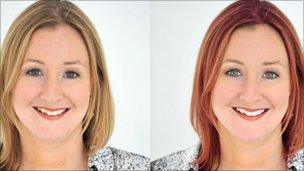Can you believe your eyes in the digital world?
- Published
Image manipulation expert Ric Bradley airbrushes Zoe Kleinman
Whether it's Obama on the beach or the impossibly flawless skin of this month's glossy cover girl, any picture can now be digitally altered to tell an entirely different story. In the age of the airbrush, can we ever really believe our eyes?
One man who can is Professor Hany Farid, a computer scientist and digital forensics expert who is a professional spotter of faked images - although he does not like the term.
"Fakery is a loaded word - I prefer alteration or manipulation," he said. "It's not always intended to be malicious."
His website features a large gallery of published images, external that aren't quite what they seem.
The oldest has been around for an astonishing 150 years - a portrait of Abraham Lincoln dated 1860 that is in fact Mr Lincoln's head on the body of another.
"It has happened throughout history," said Prof Farid. "The compositing of two people together is common - we see this over and over."
Light and shade
A magazine cover showing Hollywood couple Brad Pitt and Angelina Jolie on the beach together was actually a composite of two individual shots taken almost six months apart, he said.
"A lot of people think it's easy to spot because they often see bad fakes. But of course if you only see the bad ones you think it's easy," said Professor Farid.
His team uses scientific equations and mathematical algorithms to analyse photos looking for statistical anomalies in their composition.
Very subtle differences in shadowing are often a give-away. Identifying exactly where the shadows fall on an image reveals where the light source must have been to have created that shade.
If there is more than one source, then the image is likely composed of more than one picture.
"When you take a picture of people in two different settings the lighting is always different," he said.
"Your brain isn't sensitive to noticing it unless they are dramatically different - we are developing forensic tools to identify it."
Matter of fact
It may not be the end of the world that two movie stars were not really sunning themselves at the same time.
But the composition trick takes a more sinister turn when it is used to dramatise or even alter the recording of serious or sensitive events.

Spot the difference - Zoe Kleinman gets photoshopped.
In 2003, while actress Kate Winslet was busy hitting the headlines for complaining that she had been overly airbrushed after a magazine cover shoot, a bigger scandal was brewing.
That same year photographer Brian Walski was sacked from the LA Times after he admitted to compositing two photographs of conflict in Basra.
The two images both showed a soldier directing civilians but the second featured a man carrying a child in the background. They were composited so that the soldier appeared to be holding his hand out to stop the man., external
Afterwards Mr Walski said he had not considered the consequences of his actions at the time.
"When I put the pictures together, I knew what I was doing. It looked good. It looked better than what I had, and I said 'wow'," he told photo website PDN online, external soon afterwards.
Fast forward to 2010 and The Economist ran a front cover picture, external of US President Barack Obama looking alone and thoughtful with an oil rig in the background and the headline "Obama vs BP" - in fact he was on a beach talking to two other people who had been airbrushed out.
Deputy editor Emma Duncan said the changes were made because she "wanted the reader to focus on Obama".
"For news organisations it's not a good idea," said Professor Farid. "It's like changing a quote to make it more aesthetically pleasing."
However he added that it is not common practice in news (celebrity and fashion journalism aside) - and many news photo agencies have strict policies about how their images can be used.
"In the mainstream news it's relatively small - they are serious about photo-journalism," said Prof Farid.
Mixed reception
It's not just news editors who frown on doctored images - a manipulated picture is not admissible in court as legal evidence.
But Professor Farid thinks that the judges may be missing a trick.
A composite image showing lots of angles of a crime scene might show up evidence that one might miss by looking at a series of separate pictures, for example.
"In a court of law you cannot introduce a manipulated photo - that is altering evidence," he said.
"I would like to advocate that society starts thinking about the introduction of digital evidence in a court of law. Every year the law gets further behind the technology."
However with the media already saturated with manipulated pictures, many of which can only be identified with the help of complex mathematics, the law is erring on the side of caution for now.
Even Professor Farid admits that as technology advances, the fakes are getting harder to spot, but his methods are also evolving to keep up with the manipulators.
"The ability to tell real from fake is increasingly hard," he said.
"It's like counterfeit currency - you can't stop it but you can make it more difficult."
- Published2 July 2010